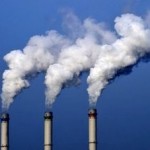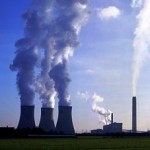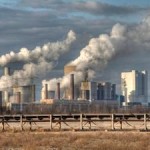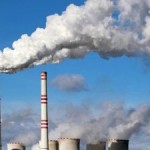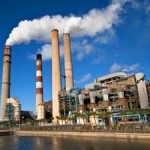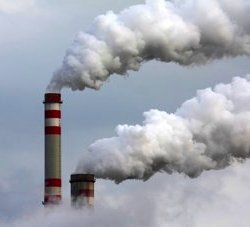 Carbon dioxide emissions, the main contributor to global warming, are set to rise again in 2014 – reaching a record high of 40 billion tonnes.
Carbon dioxide emissions, the main contributor to global warming, are set to rise again in 2014 – reaching a record high of 40 billion tonnes.
The 2.5 per cent projected rise in burning fossil fuels is revealed by the Global Carbon Project, which is co-led in the UK by researchers at the Tyndall Centre for Climate Change Research at the University of East Anglia and the College of Engineering, Mathematics and Physical Sciences at the University of Exeter.
It comes ahead of the New York Climate Summit, where world leaders will seek to catalyse action on climate change. This latest annual update of the Global Carbon Budget shows that total future CO2 emissions cannot exceed 1,200 billion tonnes – for a likely 66 per cent chance of keeping average global warming under 2°C (since pre-industrial times).
At the current rate of CO2 emissions, this 1,200 billion tonne CO2 ‘quota’ would be used up in around 30 years. This means that there is just one generation before the safeguards to a 2°C limit may be breached. The international team of climate scientists say that to avoid this, more than half of all fossil fuel reserves may need to be left unexploited.
Prof. Corinne Le Quéré, Director of the Tyndall Centre at UEA, said, “The human influence on climate change is clear. We need substantial and sustained reductions in CO2 emissions from burning fossil fuels if we are to limit global climate change. We are nowhere near the commitments necessary to stay below 2°C of climate change, a level that will be already challenging to manage for most countries around the world, even for rich nations.”
“Politicians meeting in New York need to think very carefully about their diminishing choices exposed by climate science.”
The annual Global Carbon Budget, published on September 21, includes a projection for 2014, as well as figures for 2013 by country and per capita. It is accompanied by a series of papers in Nature Climate Change, Nature Geoscience and Earth System Science Data Discussions.
Lead author of the Nature Geoscience paper, Prof. Pierre Friedlingstein from the University of Exeter said, “The time for a quiet evolution in our attitudes towards climate change is now over. Delaying action is not an option – we need to act together, and act quickly, if we are to stand a chance of avoiding climate change not long into the future, but within many of our own lifetimes.”
“We have already used two-thirds of the total amount of carbon we can burn, in order to keep warming below the crucial 2°C level. If we carry on at the current rate, we will reach our limit in as little as 30 years’ time – and that is without any continued growth in emission levels. The implication of no immediate action is worryingly clear – either we take a collective responsibility to make a difference, and soon, or it will be too late.”
Key Facts and Figures:
- CO2 emissions from burning fossil fuel are projected to rise by 2.5 per cent in 2014 – 65 per cent above 1990 levels, the reference year for the Kyoto Protocol.
- China, the USA, the EU and India are the largest emitters – together accounting for 58 per cent of emissions.
- China’s CO2 emissions grew by 4.2 per cent in 2013, the USA’s grew by 2.9 per cent, and India’s emissions grew by 5.1 per cent.
- The EU has decreased its emissions by 1.8 per cent, though it continues to export a third of its emissions to China and other producers through imported goods and services.
- China’s CO2 emissions per person overtook emissions in the EU for the first time in 2013. China’s emissions are now larger than the US and EU combined. 16 per cent of China’s emissions are for goods and services which are exported elsewhere.
- Emissions in the UK decreased by 2.6 per cent in 2013 caused by a decline in the use of coal and gas. However, the UK exports a third of its emissions by consuming goods and services which are produced elsewhere.
- CO2 emissions are caused primarily by burning fossil fuels, as well as by cement production and deforestation. Deforestation accounts for 8 per cent of CO2 emissions.
- Historical and future CO2 emissions must remain below a total 3,200 billion tonnes to be in with a 66 per cent chance of keeping climate change below 2°C. But two thirds (2,000 billion tonnes) of this quota have already been used.
- If global emissions continue at their current rate, the remaining 1,200 billion tonnes will be used up in around 30 years – one generation.
- Global emissions must reduce by more than 5 per cent each year over several decades to keep climate change below 2°C.
- This emission quota implies that over half of proven fossil reserves might have to remain unused in the ground, unless new technologies to store carbon in the ground are developed and deployed in large quantities.
The ‘Global Carbon Budget 2014’, led by UEA Tyndall Centre Director Prof. Le Quéré, is made available in the journal Earth System Science Data Discussions on September 21, 2014.
It is accompanied by a Nature Geoscience paper ‘Persistent Growth of CO2 Emissions and Implications for Reaching Climate Targets’, led by Prof. Friedlingstein from the University of Exeter. Meanwhile ‘Sharing a Quota on Cumulative Carbon Emissions’ led by Dr. Michael Raupach, Director of the Climate Change Institute at the Australian National University, and a comment article ‘Betting on Negative Emissions’, led by Dr. Sabine Fuss, at the Mercator Research Institute on Global Commons and Climate Change in Germany, are published in Nature Climate Change.
For more information, see the Global Carbon Atlas, which allows users to explore, visualise and interpret data of global, regional and national emissions:
www.globalcarbonatlas.org
Source: University of East Anglia.

